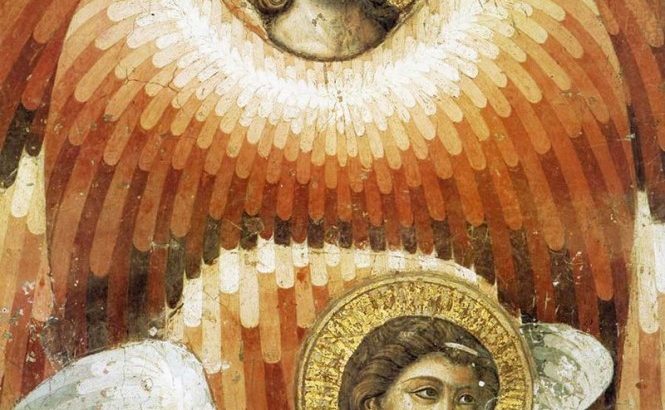Angels: A Visible and Invisible History
by Peter Stanford (Hodder & Stoughton, £20.00)
“Angels and ministers of grace defend us!”: when Hamlet encounters the ghost of his father on the parapet of Elsinore he appeals to the angels to preserve him, which is quite in keeping with the Catholic cast of Shakespeare’s imagination, poised as he was between the medieval and the modern world.
Today we are constantly told that “no-one believes in God now” – so it may come as a surprise to read that in 2016 some 10% of Britons claimed to have experienced the presence of angels.
As the author remarks, these are huge numbers, and mean that “on some counts angels are going better than God”.
Though, of course, the truth of that depends on what we mean by “angels”.
I have to admit that I cringe when I see the word ‘angel’ in a title, and try to avoid if possible the ever-increasing tide of books dealing with ‘angelology’ which seem to be largely exploitative of readers perhaps lightly grounded in their belief, or even unbelief.
This book, however, is different. Peter Stanford, a former editor of the Catholic Herald (when it was a newspaper rather than a magazine) is now a leading features writer for the Daily Telegraph. He is well known, too, for articles in other magazines or contributions on radio and TV.
A man well grounded then, but one who also writes in a lively, indeed often racy, style about religious subjects, who is able to make often hard facts more easily absorbed by readers. Perhaps I should add that he was also educated by Irish Christian Brothers, a process bound to leave a mark.
The first half of the book is devoted to the sources of belief in the Jewish tradition, early Christianity and in Islam, those monotheistic religions that derive from Abraham, of traditions and teachings about angels. The inclusion of Islam gives the books treatment a dimension often lacking in the discussions of western religion.
The second half of the book deals with the “enduring influence of angels”. What the fathers and the medieval schoolmen wrote about them, and their nature and purpose in the great scheme of things.
Scholars
These were scholars who took the whole matter with appropriate seriousness. But through art, spiritual entities were brought to light, playing their role in the decorations of Gothic cathedrals, and in the process becoming physicalised. This later led to theological disputes: Joan of Arc was condemned as a heretic because of what she said about her angelic guides.
But with the coming of the 17th Century and the influence of the very varying enlightens the angels began to be moved to the margin as he describes – they were part of the monkish concepts that were being rejected. The new breed of skeins was apt to joke about the angels supporting those great wings of theirs from and making them work from a human sternum.
To many of them the symbolism of the middle ages ( so lovingly explored by writers such as Émile Mâle) were cast aside. Finally they were placed on “on the shelf” along with all the casts-offs of the past, in a sort of charity shop of the soul.
Grassroots
The Church has come since the 1950s to speak less about angels. Though Stanford points out that the “Argentinean Pope Francis has a surer sense for what goes on at the grassroots of the Church [than Pope Benedict], and a corresponding affection for popular piety. He has gone some small way to rehabilitating angels”. This was in October, 2014.
Yet as he discusses in his conclusion, angels have a remarkable ability to survive. This we can accept. But what modern angelology seems to do is to change from being the messengers or rather ambassadors of God into self directing entities with in many of the recent books no mention of God at all. This is apt to praise even the most sceptical critic.
And yet…and yet there is something there for countless people. For instance I know a lady who at a most stressful moment of her life which she was nearly at her wits end, she felt, she encountered a woman in an almost empty church, a complete stanger to her, so in a moment of personal contact, spoke reassuring and uplifting words to her and she still feels altered her life, with a sudden flow of comfort and confidence.
Here certainly was “a minister of grace”. She felt she had encountered an angel, though not an angel in a traditional shapes. But then we must expert angels to present themselves in the costumes, not of ancient days, but of our own times.
If I understand the tradition rightly angels were conceived as God’s messengers, they did not speak for themselves, they were in fact the ambassadors of God, the porte paroles of the divine. They cannot be expected to have actual wings; that was symbolism; the reality may well be very different. They will have what Hamlet called “a questionable shape”, an appearance that can be talked with, suitable for our day.
The angel passed out of that lady’s life, its business done. But the effect on her and her family remained. Perhaps in daily life many may (in the words of Hebrews 13:2) in this way entertain angels unaware.
So when considering all that Peter Stanford has written, I have one final thought.
Perhaps we should treat everyone we meet as potentially an angel in disguise, or simply in modern dress. What a change that would make to the world as a whole!


 Peter Costello
Peter Costello Seraphim surrounding the throne of God delight in the beatific vision (detail from a fresco by Pietro Cavallini, d. 1308, in St Cecilia’s, Rome.
Seraphim surrounding the throne of God delight in the beatific vision (detail from a fresco by Pietro Cavallini, d. 1308, in St Cecilia’s, Rome. 